Emergency Planning: Principles, Incidents, and Public Response
VerifiedAdded on 2020/10/05
|11
|3384
|78
Report
AI Summary
This report delves into the multifaceted realm of emergency planning, encompassing the critical principles of effective incident response, the crucial recovery stages, and the identification of various emergency incidents both within the UK and internationally. The report meticulously examines the roles and responsibilities of public services, such as the Metropolitan Police and Oxfam, in managing and responding to these incidents. It explores the core principles of emergency management, including mitigation, preparation, response, and recovery, and highlights the significance of information and communication technology in modern emergency responses. The report further analyzes specific incidents like the Grenfell Tower fire and the Parson Green terrorist attack, illustrating the practical application of emergency planning principles and the coordinated efforts of public services. Furthermore, the report emphasizes the importance of debriefs and reviews in informing future planning and response strategies, ensuring continuous improvement in disaster management. The report offers a comprehensive overview of emergency planning, emphasizing both theoretical concepts and real-world applications, with a focus on public service roles and incident management.
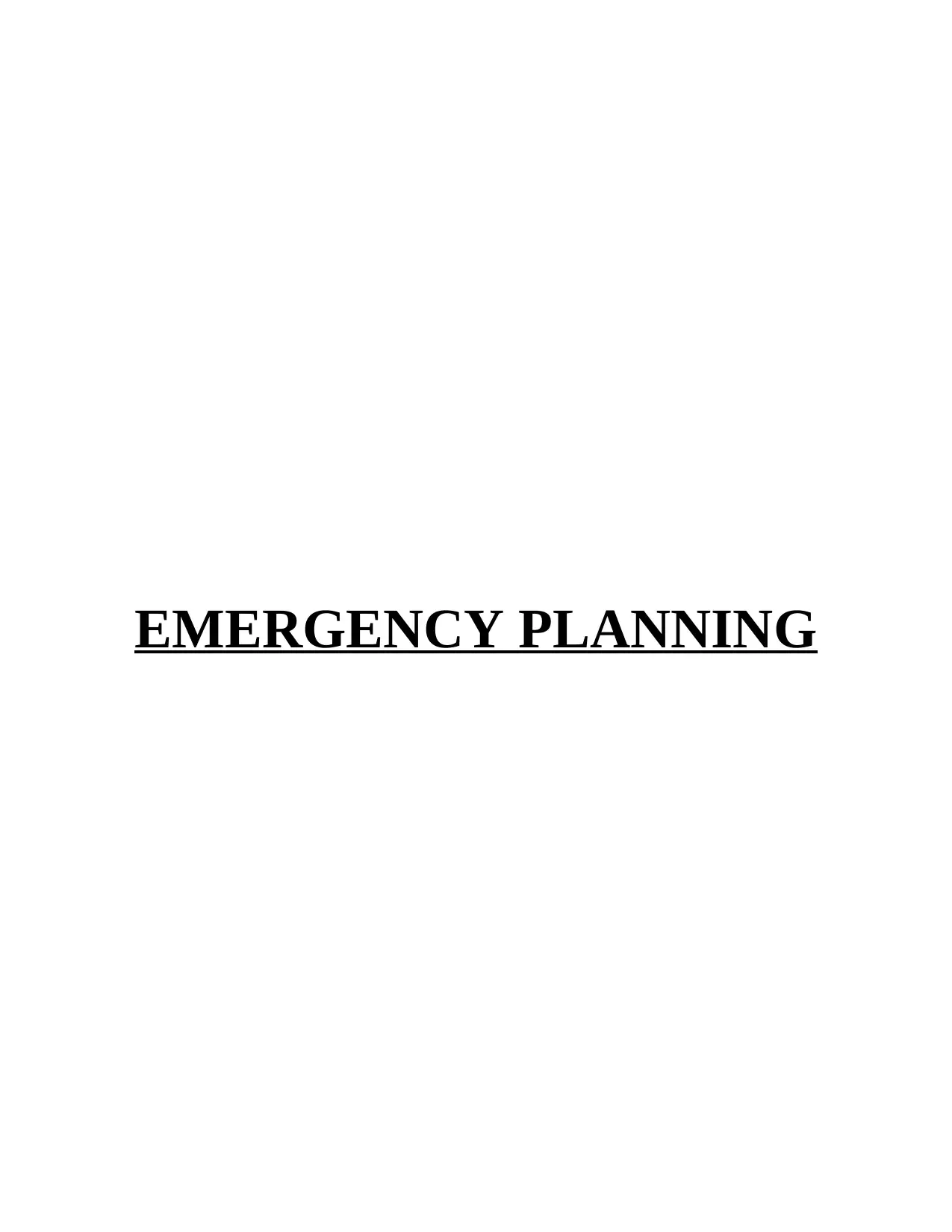
EMERGENCY PLANNING
Paraphrase This Document
Need a fresh take? Get an instant paraphrase of this document with our AI Paraphraser
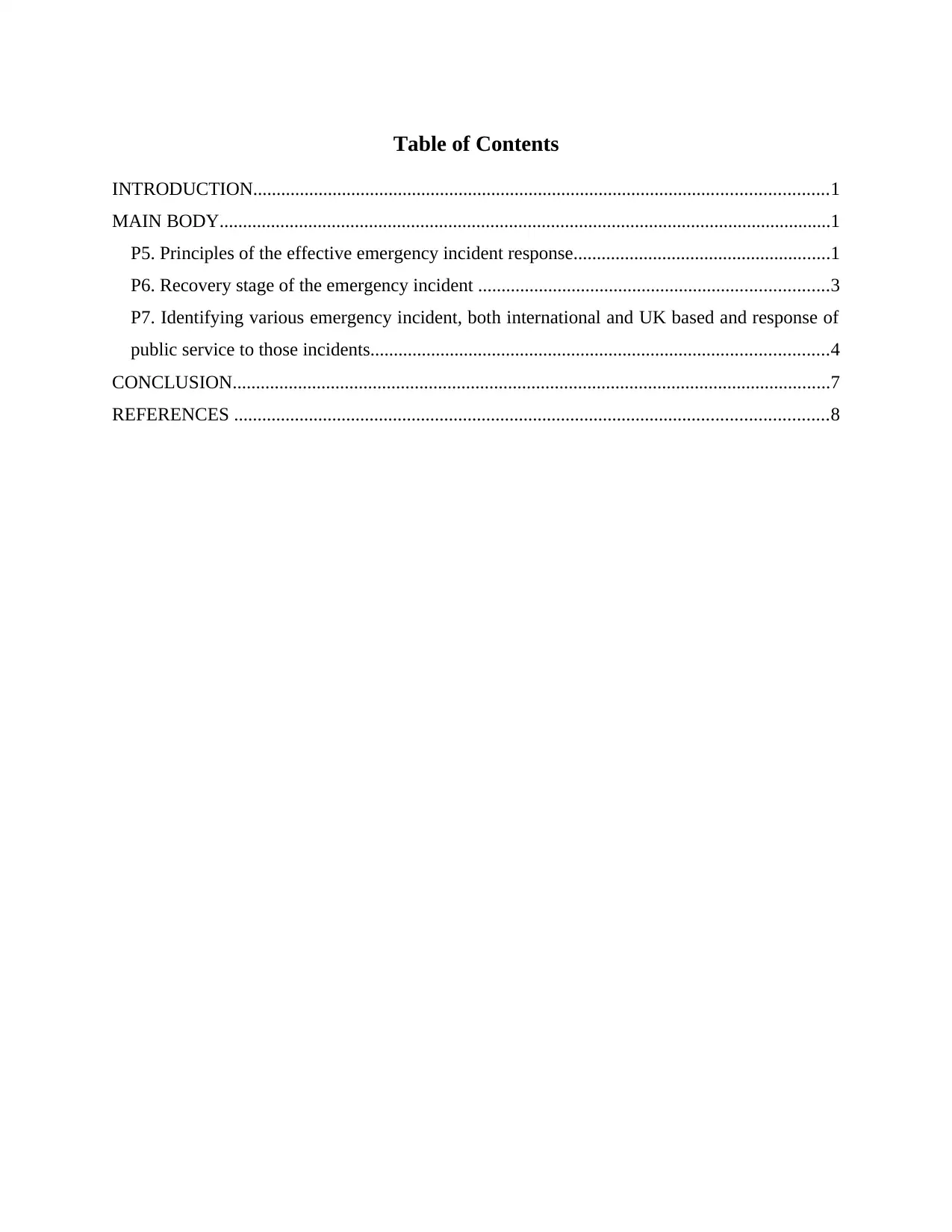
Table of Contents
INTRODUCTION...........................................................................................................................1
MAIN BODY...................................................................................................................................1
P5. Principles of the effective emergency incident response.......................................................1
P6. Recovery stage of the emergency incident ...........................................................................3
P7. Identifying various emergency incident, both international and UK based and response of
public service to those incidents..................................................................................................4
CONCLUSION................................................................................................................................7
REFERENCES ...............................................................................................................................8
INTRODUCTION...........................................................................................................................1
MAIN BODY...................................................................................................................................1
P5. Principles of the effective emergency incident response.......................................................1
P6. Recovery stage of the emergency incident ...........................................................................3
P7. Identifying various emergency incident, both international and UK based and response of
public service to those incidents..................................................................................................4
CONCLUSION................................................................................................................................7
REFERENCES ...............................................................................................................................8
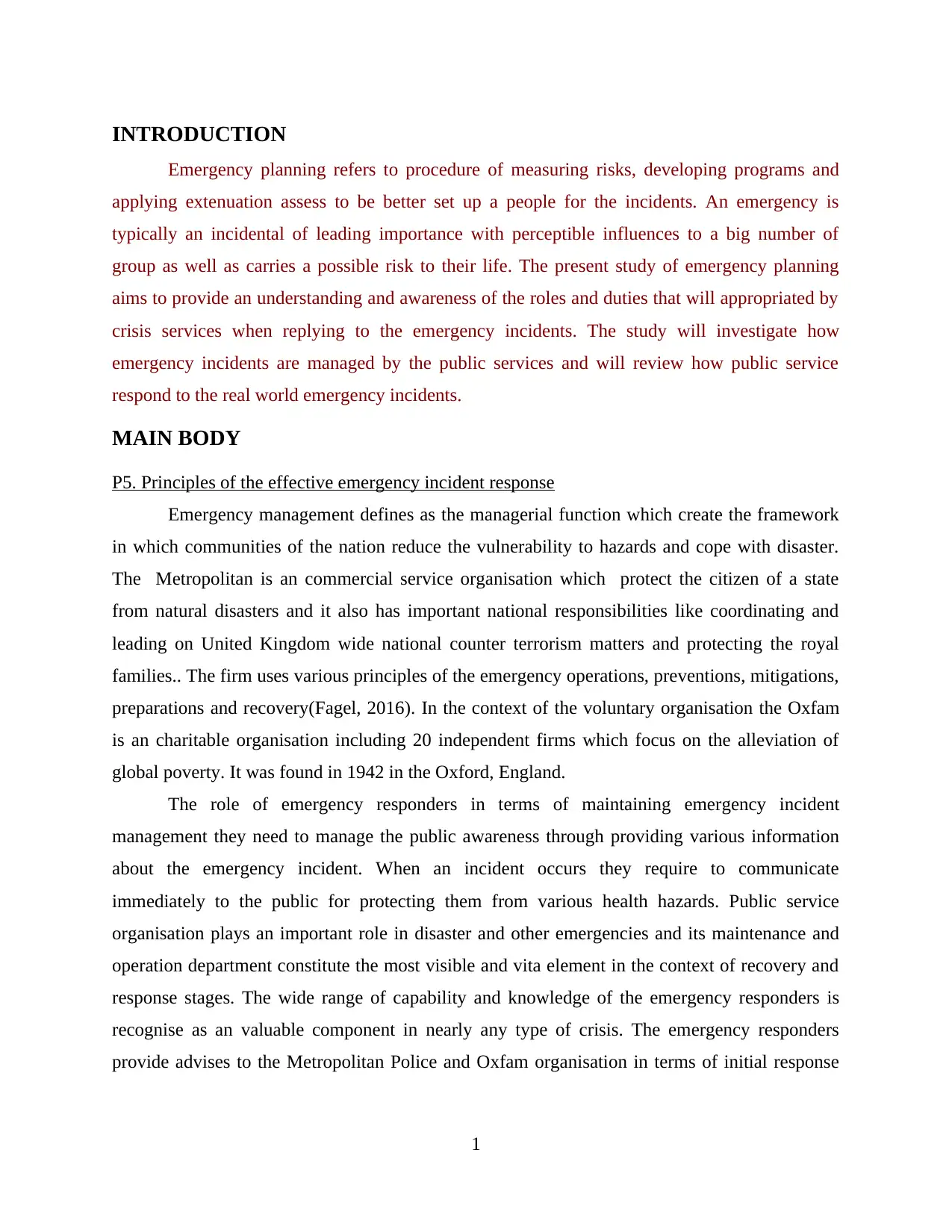
INTRODUCTION
Emergency planning refers to procedure of measuring risks, developing programs and
applying extenuation assess to be better set up a people for the incidents. An emergency is
typically an incidental of leading importance with perceptible influences to a big number of
group as well as carries a possible risk to their life. The present study of emergency planning
aims to provide an understanding and awareness of the roles and duties that will appropriated by
crisis services when replying to the emergency incidents. The study will investigate how
emergency incidents are managed by the public services and will review how public service
respond to the real world emergency incidents.
MAIN BODY
P5. Principles of the effective emergency incident response
Emergency management defines as the managerial function which create the framework
in which communities of the nation reduce the vulnerability to hazards and cope with disaster.
The Metropolitan is an commercial service organisation which protect the citizen of a state
from natural disasters and it also has important national responsibilities like coordinating and
leading on United Kingdom wide national counter terrorism matters and protecting the royal
families.. The firm uses various principles of the emergency operations, preventions, mitigations,
preparations and recovery(Fagel, 2016). In the context of the voluntary organisation the Oxfam
is an charitable organisation including 20 independent firms which focus on the alleviation of
global poverty. It was found in 1942 in the Oxford, England.
The role of emergency responders in terms of maintaining emergency incident
management they need to manage the public awareness through providing various information
about the emergency incident. When an incident occurs they require to communicate
immediately to the public for protecting them from various health hazards. Public service
organisation plays an important role in disaster and other emergencies and its maintenance and
operation department constitute the most visible and vita element in the context of recovery and
response stages. The wide range of capability and knowledge of the emergency responders is
recognise as an valuable component in nearly any type of crisis. The emergency responders
provide advises to the Metropolitan Police and Oxfam organisation in terms of initial response
1
Emergency planning refers to procedure of measuring risks, developing programs and
applying extenuation assess to be better set up a people for the incidents. An emergency is
typically an incidental of leading importance with perceptible influences to a big number of
group as well as carries a possible risk to their life. The present study of emergency planning
aims to provide an understanding and awareness of the roles and duties that will appropriated by
crisis services when replying to the emergency incidents. The study will investigate how
emergency incidents are managed by the public services and will review how public service
respond to the real world emergency incidents.
MAIN BODY
P5. Principles of the effective emergency incident response
Emergency management defines as the managerial function which create the framework
in which communities of the nation reduce the vulnerability to hazards and cope with disaster.
The Metropolitan is an commercial service organisation which protect the citizen of a state
from natural disasters and it also has important national responsibilities like coordinating and
leading on United Kingdom wide national counter terrorism matters and protecting the royal
families.. The firm uses various principles of the emergency operations, preventions, mitigations,
preparations and recovery(Fagel, 2016). In the context of the voluntary organisation the Oxfam
is an charitable organisation including 20 independent firms which focus on the alleviation of
global poverty. It was found in 1942 in the Oxford, England.
The role of emergency responders in terms of maintaining emergency incident
management they need to manage the public awareness through providing various information
about the emergency incident. When an incident occurs they require to communicate
immediately to the public for protecting them from various health hazards. Public service
organisation plays an important role in disaster and other emergencies and its maintenance and
operation department constitute the most visible and vita element in the context of recovery and
response stages. The wide range of capability and knowledge of the emergency responders is
recognise as an valuable component in nearly any type of crisis. The emergency responders
provide advises to the Metropolitan Police and Oxfam organisation in terms of initial response
1
⊘ This is a preview!⊘
Do you want full access?
Subscribe today to unlock all pages.

Trusted by 1+ million students worldwide
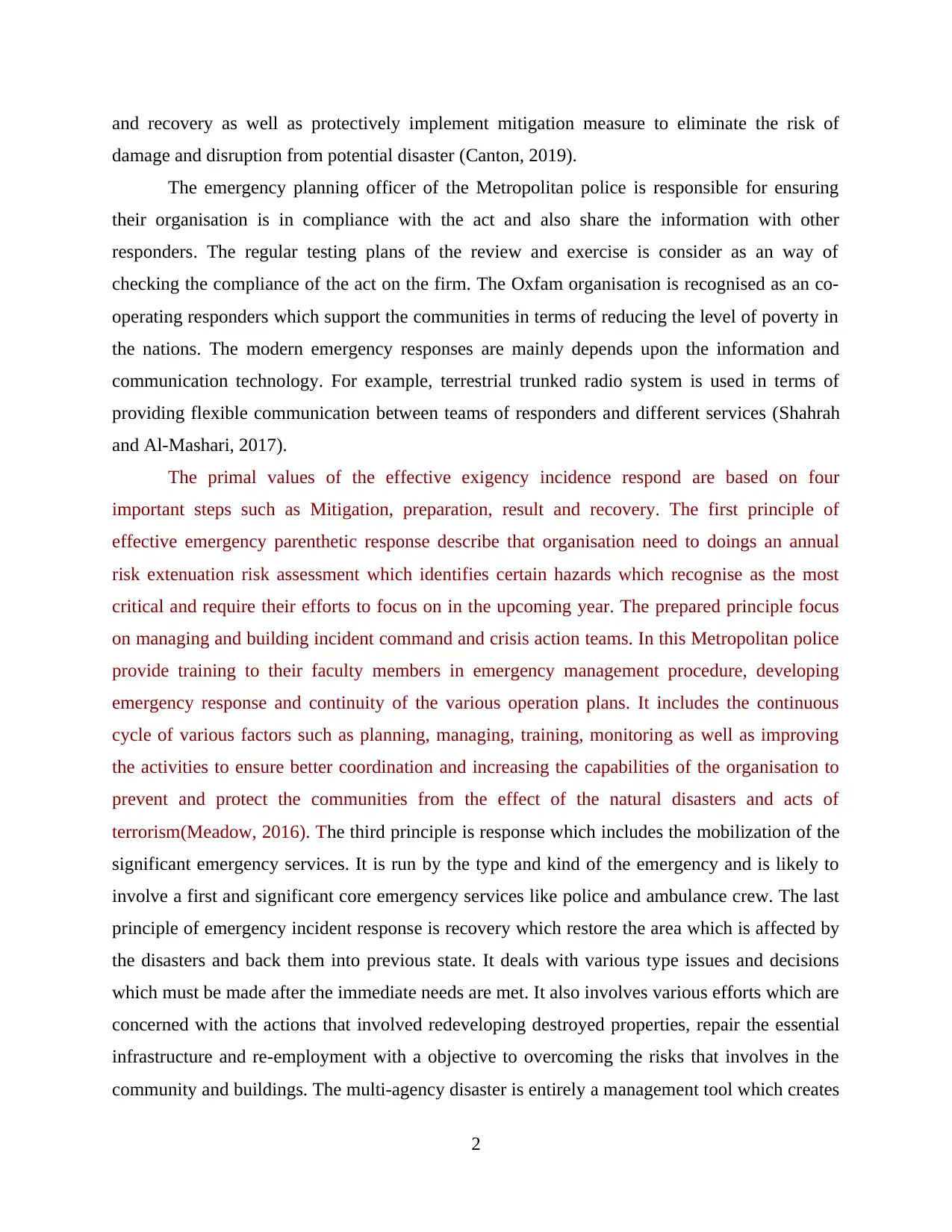
and recovery as well as protectively implement mitigation measure to eliminate the risk of
damage and disruption from potential disaster (Canton, 2019).
The emergency planning officer of the Metropolitan police is responsible for ensuring
their organisation is in compliance with the act and also share the information with other
responders. The regular testing plans of the review and exercise is consider as an way of
checking the compliance of the act on the firm. The Oxfam organisation is recognised as an co-
operating responders which support the communities in terms of reducing the level of poverty in
the nations. The modern emergency responses are mainly depends upon the information and
communication technology. For example, terrestrial trunked radio system is used in terms of
providing flexible communication between teams of responders and different services (Shahrah
and Al-Mashari, 2017).
The primal values of the effective exigency incidence respond are based on four
important steps such as Mitigation, preparation, result and recovery. The first principle of
effective emergency parenthetic response describe that organisation need to doings an annual
risk extenuation risk assessment which identifies certain hazards which recognise as the most
critical and require their efforts to focus on in the upcoming year. The prepared principle focus
on managing and building incident command and crisis action teams. In this Metropolitan police
provide training to their faculty members in emergency management procedure, developing
emergency response and continuity of the various operation plans. It includes the continuous
cycle of various factors such as planning, managing, training, monitoring as well as improving
the activities to ensure better coordination and increasing the capabilities of the organisation to
prevent and protect the communities from the effect of the natural disasters and acts of
terrorism(Meadow, 2016). The third principle is response which includes the mobilization of the
significant emergency services. It is run by the type and kind of the emergency and is likely to
involve a first and significant core emergency services like police and ambulance crew. The last
principle of emergency incident response is recovery which restore the area which is affected by
the disasters and back them into previous state. It deals with various type issues and decisions
which must be made after the immediate needs are met. It also involves various efforts which are
concerned with the actions that involved redeveloping destroyed properties, repair the essential
infrastructure and re-employment with a objective to overcoming the risks that involves in the
community and buildings. The multi-agency disaster is entirely a management tool which creates
2
damage and disruption from potential disaster (Canton, 2019).
The emergency planning officer of the Metropolitan police is responsible for ensuring
their organisation is in compliance with the act and also share the information with other
responders. The regular testing plans of the review and exercise is consider as an way of
checking the compliance of the act on the firm. The Oxfam organisation is recognised as an co-
operating responders which support the communities in terms of reducing the level of poverty in
the nations. The modern emergency responses are mainly depends upon the information and
communication technology. For example, terrestrial trunked radio system is used in terms of
providing flexible communication between teams of responders and different services (Shahrah
and Al-Mashari, 2017).
The primal values of the effective exigency incidence respond are based on four
important steps such as Mitigation, preparation, result and recovery. The first principle of
effective emergency parenthetic response describe that organisation need to doings an annual
risk extenuation risk assessment which identifies certain hazards which recognise as the most
critical and require their efforts to focus on in the upcoming year. The prepared principle focus
on managing and building incident command and crisis action teams. In this Metropolitan police
provide training to their faculty members in emergency management procedure, developing
emergency response and continuity of the various operation plans. It includes the continuous
cycle of various factors such as planning, managing, training, monitoring as well as improving
the activities to ensure better coordination and increasing the capabilities of the organisation to
prevent and protect the communities from the effect of the natural disasters and acts of
terrorism(Meadow, 2016). The third principle is response which includes the mobilization of the
significant emergency services. It is run by the type and kind of the emergency and is likely to
involve a first and significant core emergency services like police and ambulance crew. The last
principle of emergency incident response is recovery which restore the area which is affected by
the disasters and back them into previous state. It deals with various type issues and decisions
which must be made after the immediate needs are met. It also involves various efforts which are
concerned with the actions that involved redeveloping destroyed properties, repair the essential
infrastructure and re-employment with a objective to overcoming the risks that involves in the
community and buildings. The multi-agency disaster is entirely a management tool which creates
2
Paraphrase This Document
Need a fresh take? Get an instant paraphrase of this document with our AI Paraphraser
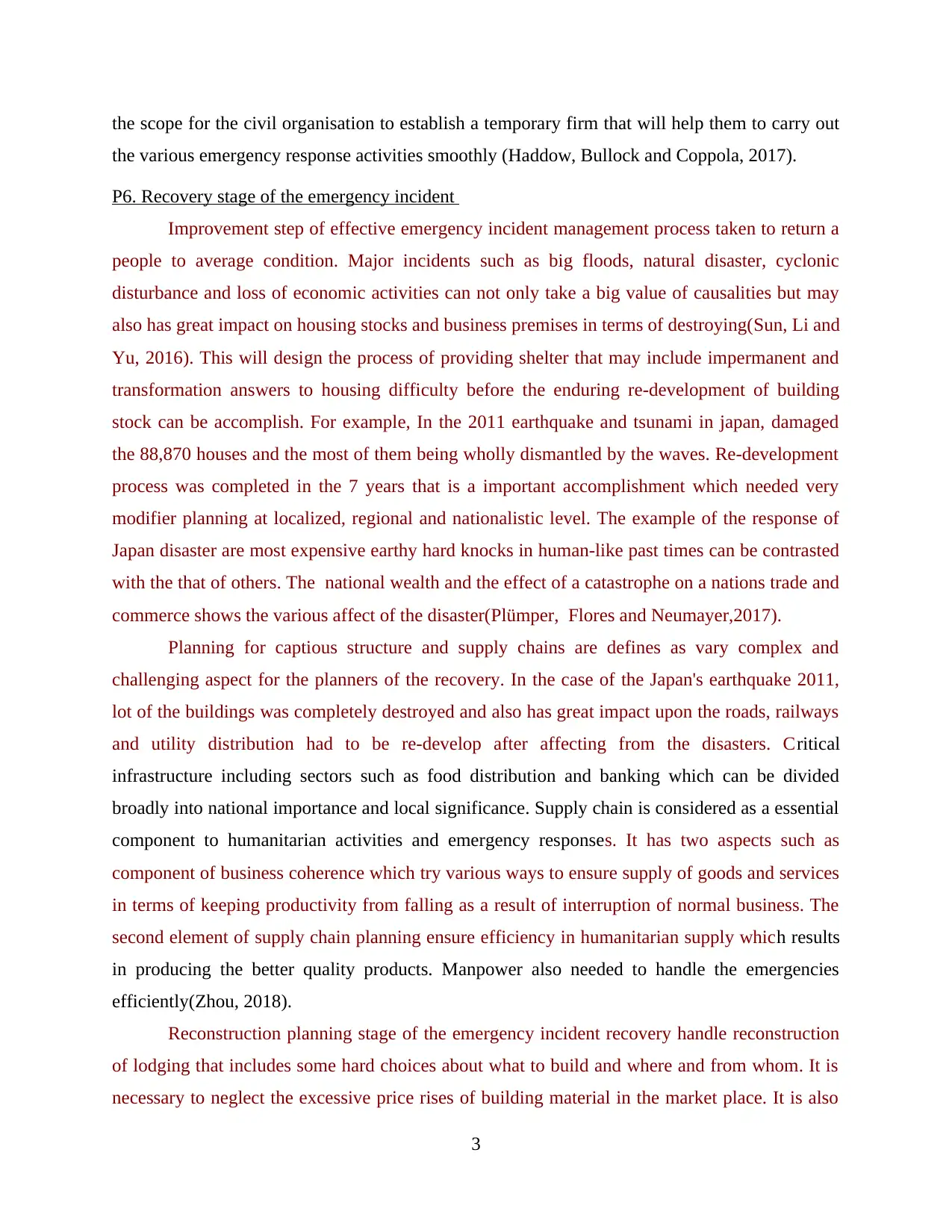
the scope for the civil organisation to establish a temporary firm that will help them to carry out
the various emergency response activities smoothly (Haddow, Bullock and Coppola, 2017).
P6. Recovery stage of the emergency incident
Improvement step of effective emergency incident management process taken to return a
people to average condition. Major incidents such as big floods, natural disaster, cyclonic
disturbance and loss of economic activities can not only take a big value of causalities but may
also has great impact on housing stocks and business premises in terms of destroying(Sun, Li and
Yu, 2016). This will design the process of providing shelter that may include impermanent and
transformation answers to housing difficulty before the enduring re-development of building
stock can be accomplish. For example, In the 2011 earthquake and tsunami in japan, damaged
the 88,870 houses and the most of them being wholly dismantled by the waves. Re-development
process was completed in the 7 years that is a important accomplishment which needed very
modifier planning at localized, regional and nationalistic level. The example of the response of
Japan disaster are most expensive earthy hard knocks in human-like past times can be contrasted
with the that of others. The national wealth and the effect of a catastrophe on a nations trade and
commerce shows the various affect of the disaster(Plümper, Flores and Neumayer,2017).
Planning for captious structure and supply chains are defines as vary complex and
challenging aspect for the planners of the recovery. In the case of the Japan's earthquake 2011,
lot of the buildings was completely destroyed and also has great impact upon the roads, railways
and utility distribution had to be re-develop after affecting from the disasters. Critical
infrastructure including sectors such as food distribution and banking which can be divided
broadly into national importance and local significance. Supply chain is considered as a essential
component to humanitarian activities and emergency responses. It has two aspects such as
component of business coherence which try various ways to ensure supply of goods and services
in terms of keeping productivity from falling as a result of interruption of normal business. The
second element of supply chain planning ensure efficiency in humanitarian supply which results
in producing the better quality products. Manpower also needed to handle the emergencies
efficiently(Zhou, 2018).
Reconstruction planning stage of the emergency incident recovery handle reconstruction
of lodging that includes some hard choices about what to build and where and from whom. It is
necessary to neglect the excessive price rises of building material in the market place. It is also
3
the various emergency response activities smoothly (Haddow, Bullock and Coppola, 2017).
P6. Recovery stage of the emergency incident
Improvement step of effective emergency incident management process taken to return a
people to average condition. Major incidents such as big floods, natural disaster, cyclonic
disturbance and loss of economic activities can not only take a big value of causalities but may
also has great impact on housing stocks and business premises in terms of destroying(Sun, Li and
Yu, 2016). This will design the process of providing shelter that may include impermanent and
transformation answers to housing difficulty before the enduring re-development of building
stock can be accomplish. For example, In the 2011 earthquake and tsunami in japan, damaged
the 88,870 houses and the most of them being wholly dismantled by the waves. Re-development
process was completed in the 7 years that is a important accomplishment which needed very
modifier planning at localized, regional and nationalistic level. The example of the response of
Japan disaster are most expensive earthy hard knocks in human-like past times can be contrasted
with the that of others. The national wealth and the effect of a catastrophe on a nations trade and
commerce shows the various affect of the disaster(Plümper, Flores and Neumayer,2017).
Planning for captious structure and supply chains are defines as vary complex and
challenging aspect for the planners of the recovery. In the case of the Japan's earthquake 2011,
lot of the buildings was completely destroyed and also has great impact upon the roads, railways
and utility distribution had to be re-develop after affecting from the disasters. Critical
infrastructure including sectors such as food distribution and banking which can be divided
broadly into national importance and local significance. Supply chain is considered as a essential
component to humanitarian activities and emergency responses. It has two aspects such as
component of business coherence which try various ways to ensure supply of goods and services
in terms of keeping productivity from falling as a result of interruption of normal business. The
second element of supply chain planning ensure efficiency in humanitarian supply which results
in producing the better quality products. Manpower also needed to handle the emergencies
efficiently(Zhou, 2018).
Reconstruction planning stage of the emergency incident recovery handle reconstruction
of lodging that includes some hard choices about what to build and where and from whom. It is
necessary to neglect the excessive price rises of building material in the market place. It is also
3
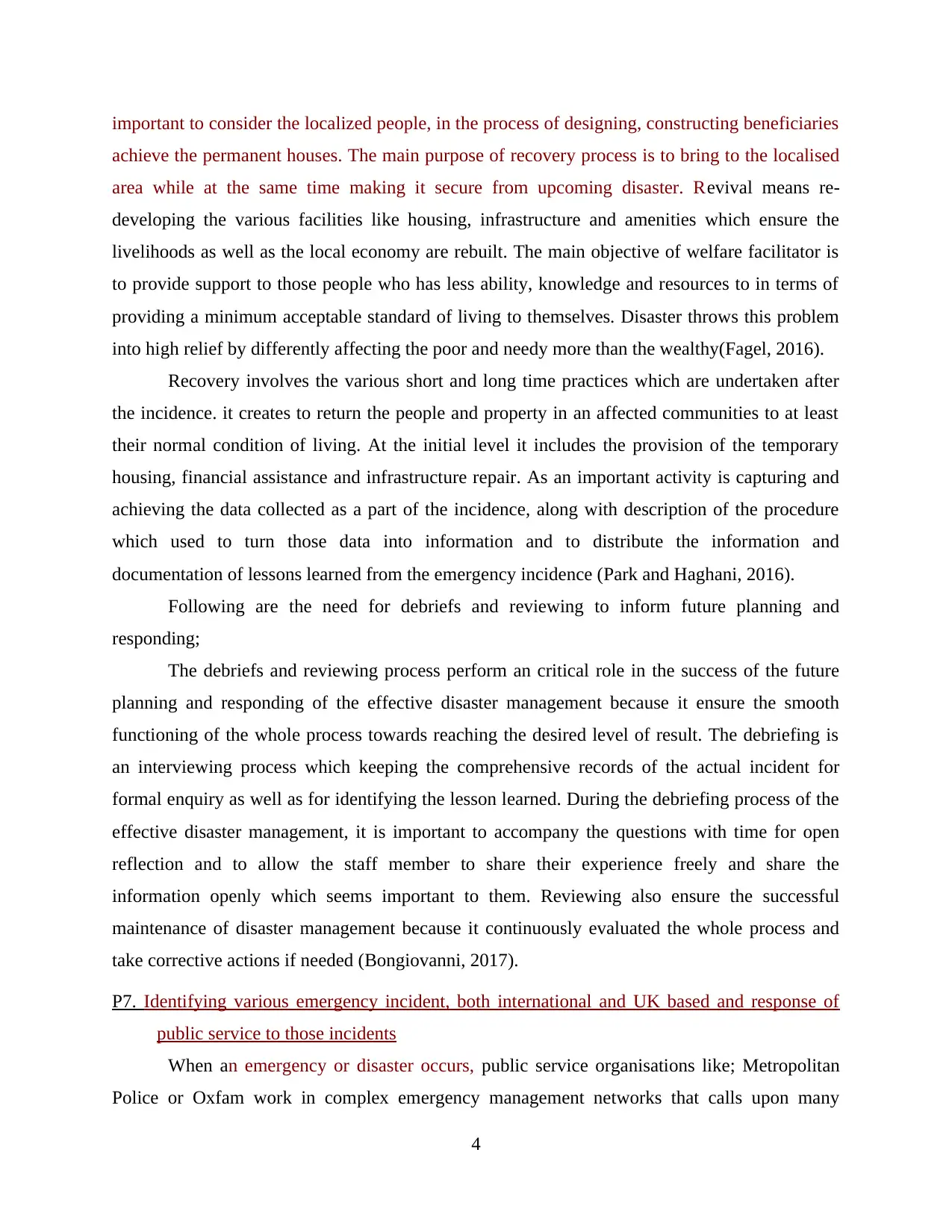
important to consider the localized people, in the process of designing, constructing beneficiaries
achieve the permanent houses. The main purpose of recovery process is to bring to the localised
area while at the same time making it secure from upcoming disaster. Revival means re-
developing the various facilities like housing, infrastructure and amenities which ensure the
livelihoods as well as the local economy are rebuilt. The main objective of welfare facilitator is
to provide support to those people who has less ability, knowledge and resources to in terms of
providing a minimum acceptable standard of living to themselves. Disaster throws this problem
into high relief by differently affecting the poor and needy more than the wealthy(Fagel, 2016).
Recovery involves the various short and long time practices which are undertaken after
the incidence. it creates to return the people and property in an affected communities to at least
their normal condition of living. At the initial level it includes the provision of the temporary
housing, financial assistance and infrastructure repair. As an important activity is capturing and
achieving the data collected as a part of the incidence, along with description of the procedure
which used to turn those data into information and to distribute the information and
documentation of lessons learned from the emergency incidence (Park and Haghani, 2016).
Following are the need for debriefs and reviewing to inform future planning and
responding;
The debriefs and reviewing process perform an critical role in the success of the future
planning and responding of the effective disaster management because it ensure the smooth
functioning of the whole process towards reaching the desired level of result. The debriefing is
an interviewing process which keeping the comprehensive records of the actual incident for
formal enquiry as well as for identifying the lesson learned. During the debriefing process of the
effective disaster management, it is important to accompany the questions with time for open
reflection and to allow the staff member to share their experience freely and share the
information openly which seems important to them. Reviewing also ensure the successful
maintenance of disaster management because it continuously evaluated the whole process and
take corrective actions if needed (Bongiovanni, 2017).
P7. Identifying various emergency incident, both international and UK based and response of
public service to those incidents
When an emergency or disaster occurs, public service organisations like; Metropolitan
Police or Oxfam work in complex emergency management networks that calls upon many
4
achieve the permanent houses. The main purpose of recovery process is to bring to the localised
area while at the same time making it secure from upcoming disaster. Revival means re-
developing the various facilities like housing, infrastructure and amenities which ensure the
livelihoods as well as the local economy are rebuilt. The main objective of welfare facilitator is
to provide support to those people who has less ability, knowledge and resources to in terms of
providing a minimum acceptable standard of living to themselves. Disaster throws this problem
into high relief by differently affecting the poor and needy more than the wealthy(Fagel, 2016).
Recovery involves the various short and long time practices which are undertaken after
the incidence. it creates to return the people and property in an affected communities to at least
their normal condition of living. At the initial level it includes the provision of the temporary
housing, financial assistance and infrastructure repair. As an important activity is capturing and
achieving the data collected as a part of the incidence, along with description of the procedure
which used to turn those data into information and to distribute the information and
documentation of lessons learned from the emergency incidence (Park and Haghani, 2016).
Following are the need for debriefs and reviewing to inform future planning and
responding;
The debriefs and reviewing process perform an critical role in the success of the future
planning and responding of the effective disaster management because it ensure the smooth
functioning of the whole process towards reaching the desired level of result. The debriefing is
an interviewing process which keeping the comprehensive records of the actual incident for
formal enquiry as well as for identifying the lesson learned. During the debriefing process of the
effective disaster management, it is important to accompany the questions with time for open
reflection and to allow the staff member to share their experience freely and share the
information openly which seems important to them. Reviewing also ensure the successful
maintenance of disaster management because it continuously evaluated the whole process and
take corrective actions if needed (Bongiovanni, 2017).
P7. Identifying various emergency incident, both international and UK based and response of
public service to those incidents
When an emergency or disaster occurs, public service organisations like; Metropolitan
Police or Oxfam work in complex emergency management networks that calls upon many
4
⊘ This is a preview!⊘
Do you want full access?
Subscribe today to unlock all pages.

Trusted by 1+ million students worldwide
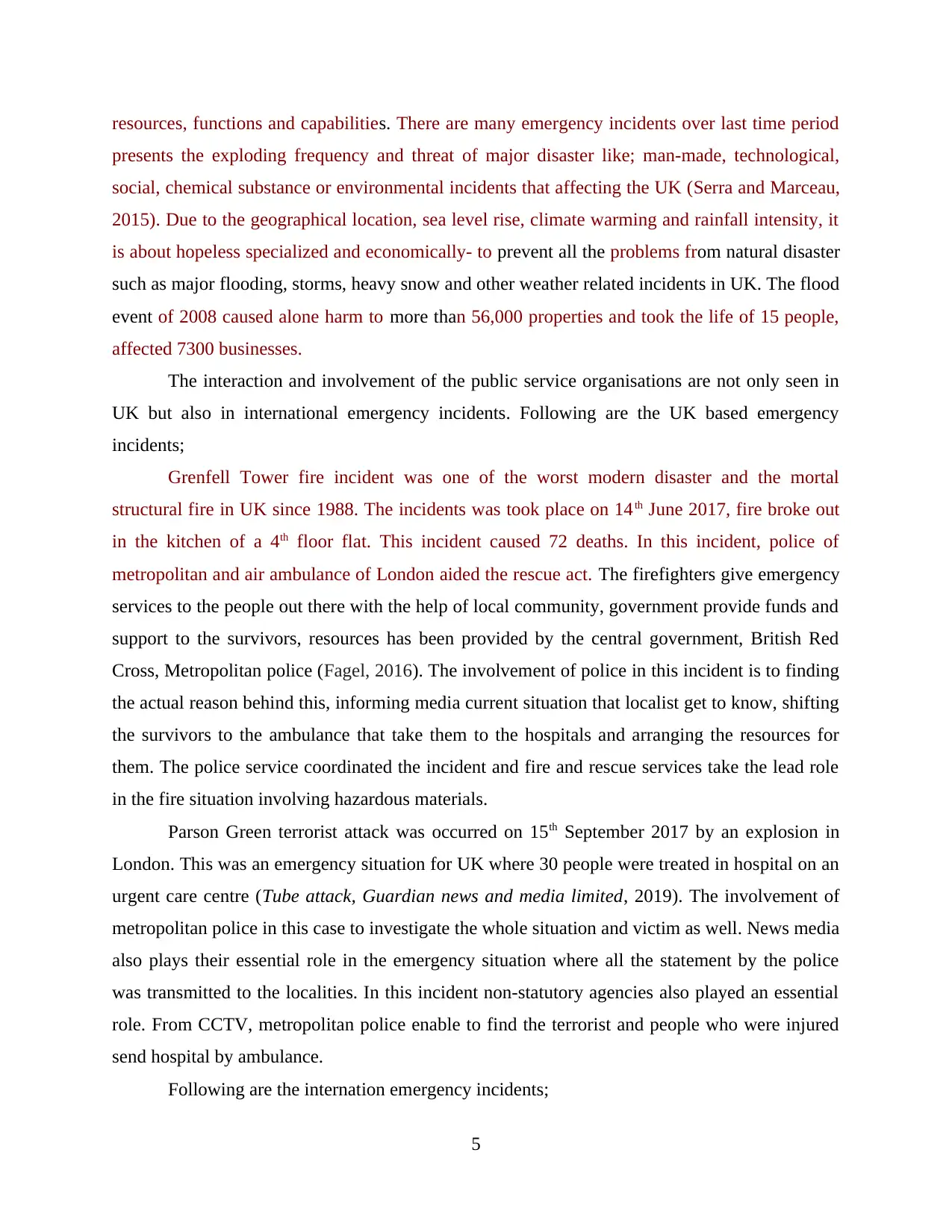
resources, functions and capabilities. There are many emergency incidents over last time period
presents the exploding frequency and threat of major disaster like; man-made, technological,
social, chemical substance or environmental incidents that affecting the UK (Serra and Marceau,
2015). Due to the geographical location, sea level rise, climate warming and rainfall intensity, it
is about hopeless specialized and economically- to prevent all the problems from natural disaster
such as major flooding, storms, heavy snow and other weather related incidents in UK. The flood
event of 2008 caused alone harm to more than 56,000 properties and took the life of 15 people,
affected 7300 businesses.
The interaction and involvement of the public service organisations are not only seen in
UK but also in international emergency incidents. Following are the UK based emergency
incidents;
Grenfell Tower fire incident was one of the worst modern disaster and the mortal
structural fire in UK since 1988. The incidents was took place on 14th June 2017, fire broke out
in the kitchen of a 4th floor flat. This incident caused 72 deaths. In this incident, police of
metropolitan and air ambulance of London aided the rescue act. The firefighters give emergency
services to the people out there with the help of local community, government provide funds and
support to the survivors, resources has been provided by the central government, British Red
Cross, Metropolitan police (Fagel, 2016). The involvement of police in this incident is to finding
the actual reason behind this, informing media current situation that localist get to know, shifting
the survivors to the ambulance that take them to the hospitals and arranging the resources for
them. The police service coordinated the incident and fire and rescue services take the lead role
in the fire situation involving hazardous materials.
Parson Green terrorist attack was occurred on 15th September 2017 by an explosion in
London. This was an emergency situation for UK where 30 people were treated in hospital on an
urgent care centre (Tube attack, Guardian news and media limited, 2019). The involvement of
metropolitan police in this case to investigate the whole situation and victim as well. News media
also plays their essential role in the emergency situation where all the statement by the police
was transmitted to the localities. In this incident non-statutory agencies also played an essential
role. From CCTV, metropolitan police enable to find the terrorist and people who were injured
send hospital by ambulance.
Following are the internation emergency incidents;
5
presents the exploding frequency and threat of major disaster like; man-made, technological,
social, chemical substance or environmental incidents that affecting the UK (Serra and Marceau,
2015). Due to the geographical location, sea level rise, climate warming and rainfall intensity, it
is about hopeless specialized and economically- to prevent all the problems from natural disaster
such as major flooding, storms, heavy snow and other weather related incidents in UK. The flood
event of 2008 caused alone harm to more than 56,000 properties and took the life of 15 people,
affected 7300 businesses.
The interaction and involvement of the public service organisations are not only seen in
UK but also in international emergency incidents. Following are the UK based emergency
incidents;
Grenfell Tower fire incident was one of the worst modern disaster and the mortal
structural fire in UK since 1988. The incidents was took place on 14th June 2017, fire broke out
in the kitchen of a 4th floor flat. This incident caused 72 deaths. In this incident, police of
metropolitan and air ambulance of London aided the rescue act. The firefighters give emergency
services to the people out there with the help of local community, government provide funds and
support to the survivors, resources has been provided by the central government, British Red
Cross, Metropolitan police (Fagel, 2016). The involvement of police in this incident is to finding
the actual reason behind this, informing media current situation that localist get to know, shifting
the survivors to the ambulance that take them to the hospitals and arranging the resources for
them. The police service coordinated the incident and fire and rescue services take the lead role
in the fire situation involving hazardous materials.
Parson Green terrorist attack was occurred on 15th September 2017 by an explosion in
London. This was an emergency situation for UK where 30 people were treated in hospital on an
urgent care centre (Tube attack, Guardian news and media limited, 2019). The involvement of
metropolitan police in this case to investigate the whole situation and victim as well. News media
also plays their essential role in the emergency situation where all the statement by the police
was transmitted to the localities. In this incident non-statutory agencies also played an essential
role. From CCTV, metropolitan police enable to find the terrorist and people who were injured
send hospital by ambulance.
Following are the internation emergency incidents;
5
Paraphrase This Document
Need a fresh take? Get an instant paraphrase of this document with our AI Paraphraser
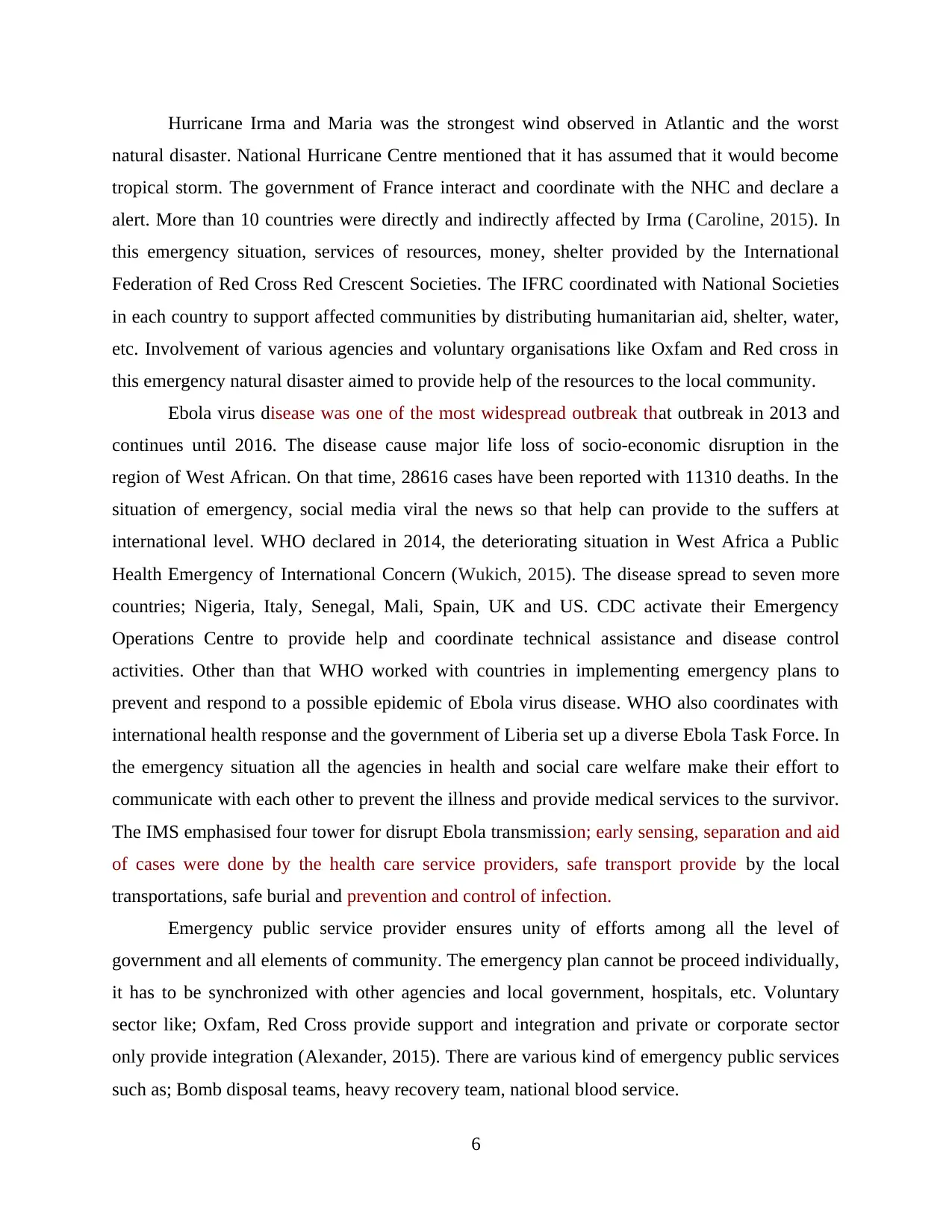
Hurricane Irma and Maria was the strongest wind observed in Atlantic and the worst
natural disaster. National Hurricane Centre mentioned that it has assumed that it would become
tropical storm. The government of France interact and coordinate with the NHC and declare a
alert. More than 10 countries were directly and indirectly affected by Irma (Caroline, 2015). In
this emergency situation, services of resources, money, shelter provided by the International
Federation of Red Cross Red Crescent Societies. The IFRC coordinated with National Societies
in each country to support affected communities by distributing humanitarian aid, shelter, water,
etc. Involvement of various agencies and voluntary organisations like Oxfam and Red cross in
this emergency natural disaster aimed to provide help of the resources to the local community.
Ebola virus disease was one of the most widespread outbreak that outbreak in 2013 and
continues until 2016. The disease cause major life loss of socio-economic disruption in the
region of West African. On that time, 28616 cases have been reported with 11310 deaths. In the
situation of emergency, social media viral the news so that help can provide to the suffers at
international level. WHO declared in 2014, the deteriorating situation in West Africa a Public
Health Emergency of International Concern (Wukich, 2015). The disease spread to seven more
countries; Nigeria, Italy, Senegal, Mali, Spain, UK and US. CDC activate their Emergency
Operations Centre to provide help and coordinate technical assistance and disease control
activities. Other than that WHO worked with countries in implementing emergency plans to
prevent and respond to a possible epidemic of Ebola virus disease. WHO also coordinates with
international health response and the government of Liberia set up a diverse Ebola Task Force. In
the emergency situation all the agencies in health and social care welfare make their effort to
communicate with each other to prevent the illness and provide medical services to the survivor.
The IMS emphasised four tower for disrupt Ebola transmission; early sensing, separation and aid
of cases were done by the health care service providers, safe transport provide by the local
transportations, safe burial and prevention and control of infection.
Emergency public service provider ensures unity of efforts among all the level of
government and all elements of community. The emergency plan cannot be proceed individually,
it has to be synchronized with other agencies and local government, hospitals, etc. Voluntary
sector like; Oxfam, Red Cross provide support and integration and private or corporate sector
only provide integration (Alexander, 2015). There are various kind of emergency public services
such as; Bomb disposal teams, heavy recovery team, national blood service.
6
natural disaster. National Hurricane Centre mentioned that it has assumed that it would become
tropical storm. The government of France interact and coordinate with the NHC and declare a
alert. More than 10 countries were directly and indirectly affected by Irma (Caroline, 2015). In
this emergency situation, services of resources, money, shelter provided by the International
Federation of Red Cross Red Crescent Societies. The IFRC coordinated with National Societies
in each country to support affected communities by distributing humanitarian aid, shelter, water,
etc. Involvement of various agencies and voluntary organisations like Oxfam and Red cross in
this emergency natural disaster aimed to provide help of the resources to the local community.
Ebola virus disease was one of the most widespread outbreak that outbreak in 2013 and
continues until 2016. The disease cause major life loss of socio-economic disruption in the
region of West African. On that time, 28616 cases have been reported with 11310 deaths. In the
situation of emergency, social media viral the news so that help can provide to the suffers at
international level. WHO declared in 2014, the deteriorating situation in West Africa a Public
Health Emergency of International Concern (Wukich, 2015). The disease spread to seven more
countries; Nigeria, Italy, Senegal, Mali, Spain, UK and US. CDC activate their Emergency
Operations Centre to provide help and coordinate technical assistance and disease control
activities. Other than that WHO worked with countries in implementing emergency plans to
prevent and respond to a possible epidemic of Ebola virus disease. WHO also coordinates with
international health response and the government of Liberia set up a diverse Ebola Task Force. In
the emergency situation all the agencies in health and social care welfare make their effort to
communicate with each other to prevent the illness and provide medical services to the survivor.
The IMS emphasised four tower for disrupt Ebola transmission; early sensing, separation and aid
of cases were done by the health care service providers, safe transport provide by the local
transportations, safe burial and prevention and control of infection.
Emergency public service provider ensures unity of efforts among all the level of
government and all elements of community. The emergency plan cannot be proceed individually,
it has to be synchronized with other agencies and local government, hospitals, etc. Voluntary
sector like; Oxfam, Red Cross provide support and integration and private or corporate sector
only provide integration (Alexander, 2015). There are various kind of emergency public services
such as; Bomb disposal teams, heavy recovery team, national blood service.
6
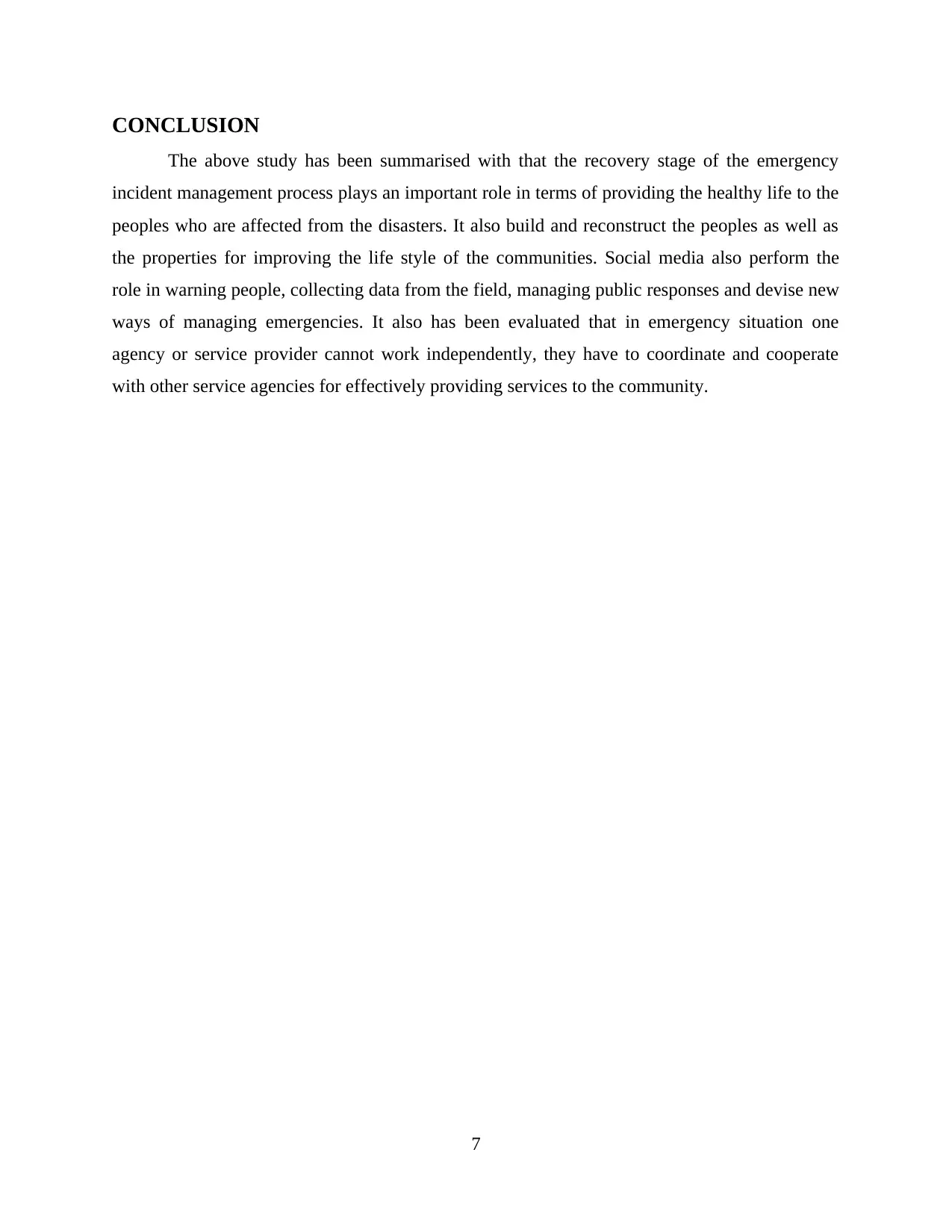
CONCLUSION
The above study has been summarised with that the recovery stage of the emergency
incident management process plays an important role in terms of providing the healthy life to the
peoples who are affected from the disasters. It also build and reconstruct the peoples as well as
the properties for improving the life style of the communities. Social media also perform the
role in warning people, collecting data from the field, managing public responses and devise new
ways of managing emergencies. It also has been evaluated that in emergency situation one
agency or service provider cannot work independently, they have to coordinate and cooperate
with other service agencies for effectively providing services to the community.
7
The above study has been summarised with that the recovery stage of the emergency
incident management process plays an important role in terms of providing the healthy life to the
peoples who are affected from the disasters. It also build and reconstruct the peoples as well as
the properties for improving the life style of the communities. Social media also perform the
role in warning people, collecting data from the field, managing public responses and devise new
ways of managing emergencies. It also has been evaluated that in emergency situation one
agency or service provider cannot work independently, they have to coordinate and cooperate
with other service agencies for effectively providing services to the community.
7
⊘ This is a preview!⊘
Do you want full access?
Subscribe today to unlock all pages.

Trusted by 1+ million students worldwide
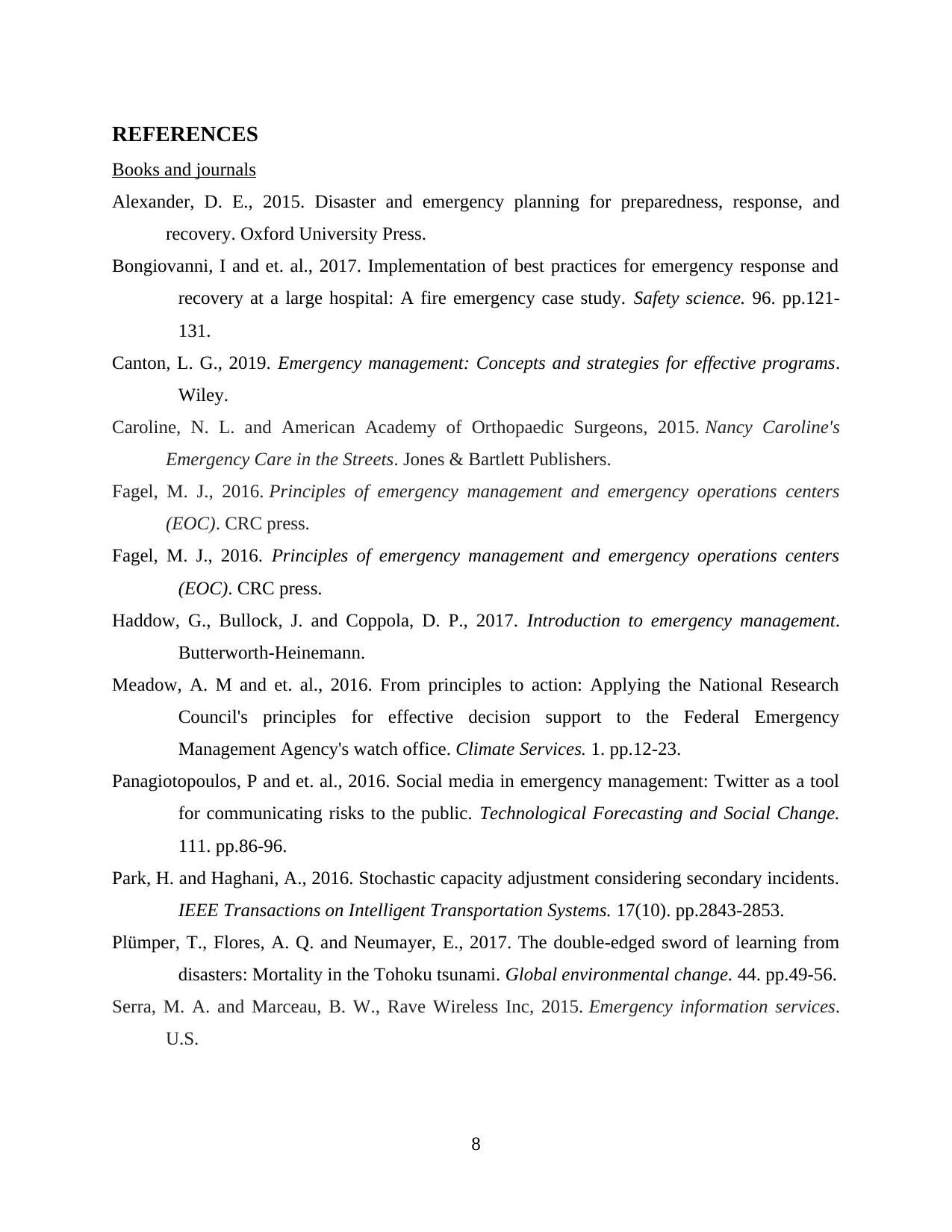
REFERENCES
Books and journals
Alexander, D. E., 2015. Disaster and emergency planning for preparedness, response, and
recovery. Oxford University Press.
Bongiovanni, I and et. al., 2017. Implementation of best practices for emergency response and
recovery at a large hospital: A fire emergency case study. Safety science. 96. pp.121-
131.
Canton, L. G., 2019. Emergency management: Concepts and strategies for effective programs.
Wiley.
Caroline, N. L. and American Academy of Orthopaedic Surgeons, 2015. Nancy Caroline's
Emergency Care in the Streets. Jones & Bartlett Publishers.
Fagel, M. J., 2016. Principles of emergency management and emergency operations centers
(EOC). CRC press.
Fagel, M. J., 2016. Principles of emergency management and emergency operations centers
(EOC). CRC press.
Haddow, G., Bullock, J. and Coppola, D. P., 2017. Introduction to emergency management.
Butterworth-Heinemann.
Meadow, A. M and et. al., 2016. From principles to action: Applying the National Research
Council's principles for effective decision support to the Federal Emergency
Management Agency's watch office. Climate Services. 1. pp.12-23.
Panagiotopoulos, P and et. al., 2016. Social media in emergency management: Twitter as a tool
for communicating risks to the public. Technological Forecasting and Social Change.
111. pp.86-96.
Park, H. and Haghani, A., 2016. Stochastic capacity adjustment considering secondary incidents.
IEEE Transactions on Intelligent Transportation Systems. 17(10). pp.2843-2853.
Plümper, T., Flores, A. Q. and Neumayer, E., 2017. The double-edged sword of learning from
disasters: Mortality in the Tohoku tsunami. Global environmental change. 44. pp.49-56.
Serra, M. A. and Marceau, B. W., Rave Wireless Inc, 2015. Emergency information services.
U.S.
8
Books and journals
Alexander, D. E., 2015. Disaster and emergency planning for preparedness, response, and
recovery. Oxford University Press.
Bongiovanni, I and et. al., 2017. Implementation of best practices for emergency response and
recovery at a large hospital: A fire emergency case study. Safety science. 96. pp.121-
131.
Canton, L. G., 2019. Emergency management: Concepts and strategies for effective programs.
Wiley.
Caroline, N. L. and American Academy of Orthopaedic Surgeons, 2015. Nancy Caroline's
Emergency Care in the Streets. Jones & Bartlett Publishers.
Fagel, M. J., 2016. Principles of emergency management and emergency operations centers
(EOC). CRC press.
Fagel, M. J., 2016. Principles of emergency management and emergency operations centers
(EOC). CRC press.
Haddow, G., Bullock, J. and Coppola, D. P., 2017. Introduction to emergency management.
Butterworth-Heinemann.
Meadow, A. M and et. al., 2016. From principles to action: Applying the National Research
Council's principles for effective decision support to the Federal Emergency
Management Agency's watch office. Climate Services. 1. pp.12-23.
Panagiotopoulos, P and et. al., 2016. Social media in emergency management: Twitter as a tool
for communicating risks to the public. Technological Forecasting and Social Change.
111. pp.86-96.
Park, H. and Haghani, A., 2016. Stochastic capacity adjustment considering secondary incidents.
IEEE Transactions on Intelligent Transportation Systems. 17(10). pp.2843-2853.
Plümper, T., Flores, A. Q. and Neumayer, E., 2017. The double-edged sword of learning from
disasters: Mortality in the Tohoku tsunami. Global environmental change. 44. pp.49-56.
Serra, M. A. and Marceau, B. W., Rave Wireless Inc, 2015. Emergency information services.
U.S.
8
Paraphrase This Document
Need a fresh take? Get an instant paraphrase of this document with our AI Paraphraser
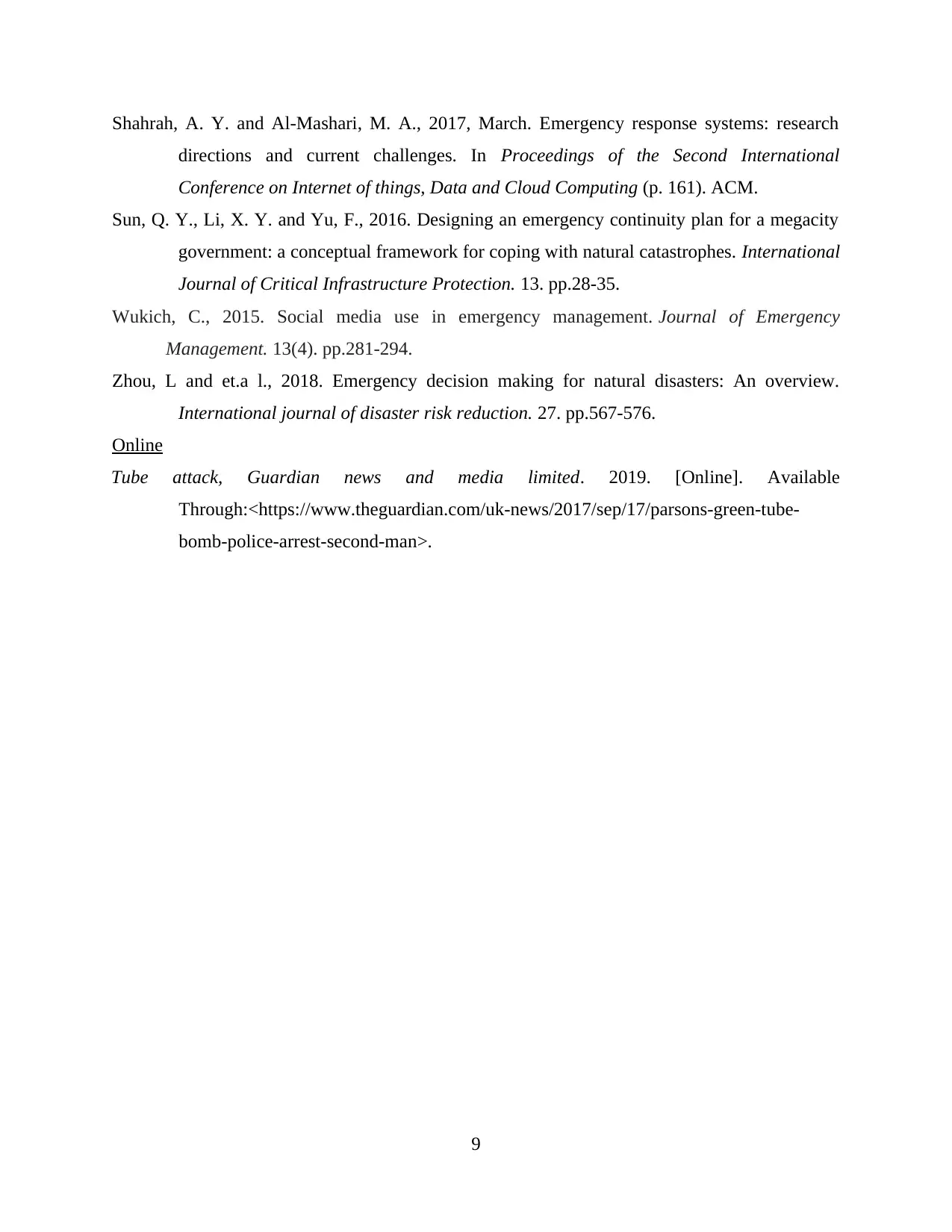
Shahrah, A. Y. and Al-Mashari, M. A., 2017, March. Emergency response systems: research
directions and current challenges. In Proceedings of the Second International
Conference on Internet of things, Data and Cloud Computing (p. 161). ACM.
Sun, Q. Y., Li, X. Y. and Yu, F., 2016. Designing an emergency continuity plan for a megacity
government: a conceptual framework for coping with natural catastrophes. International
Journal of Critical Infrastructure Protection. 13. pp.28-35.
Wukich, C., 2015. Social media use in emergency management. Journal of Emergency
Management. 13(4). pp.281-294.
Zhou, L and et.a l., 2018. Emergency decision making for natural disasters: An overview.
International journal of disaster risk reduction. 27. pp.567-576.
Online
Tube attack, Guardian news and media limited. 2019. [Online]. Available
Through:<https://www.theguardian.com/uk-news/2017/sep/17/parsons-green-tube-
bomb-police-arrest-second-man>.
9
directions and current challenges. In Proceedings of the Second International
Conference on Internet of things, Data and Cloud Computing (p. 161). ACM.
Sun, Q. Y., Li, X. Y. and Yu, F., 2016. Designing an emergency continuity plan for a megacity
government: a conceptual framework for coping with natural catastrophes. International
Journal of Critical Infrastructure Protection. 13. pp.28-35.
Wukich, C., 2015. Social media use in emergency management. Journal of Emergency
Management. 13(4). pp.281-294.
Zhou, L and et.a l., 2018. Emergency decision making for natural disasters: An overview.
International journal of disaster risk reduction. 27. pp.567-576.
Online
Tube attack, Guardian news and media limited. 2019. [Online]. Available
Through:<https://www.theguardian.com/uk-news/2017/sep/17/parsons-green-tube-
bomb-police-arrest-second-man>.
9
1 out of 11
Related Documents
Your All-in-One AI-Powered Toolkit for Academic Success.
+13062052269
info@desklib.com
Available 24*7 on WhatsApp / Email
![[object Object]](/_next/static/media/star-bottom.7253800d.svg)
Unlock your academic potential
Copyright © 2020–2025 A2Z Services. All Rights Reserved. Developed and managed by ZUCOL.




